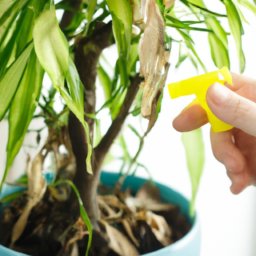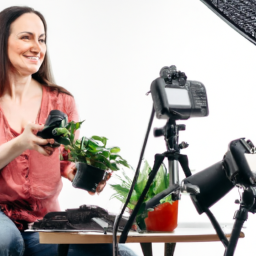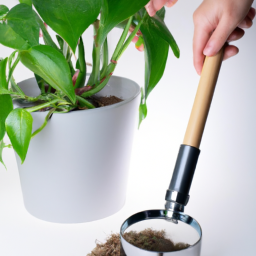
Are your plants not thriving as they should? Are you struggling to keep them healthy and vibrant? If so, you’re in the right place! In this blog post, we will discuss the common challenges faced by plant owners when it comes to watering and providing adequate light. Adjusting plant care is crucial to solving these watering and light-related issues, and we’re here to help you navigate through them. Whether you’re a seasoned plant parent or just starting out, read on to discover practical tips and tricks that will ensure your plants receive the care they need to flourish.
h2 {
font-size: 24px;
font-weight: bold;
margin-bottom: 10px;
}
h3 {
font-size: 20px;
font-weight: bold;
margin-bottom: 5px;
}
p {
font-size: 16px;
line-height: 1.5;
margin-bottom: 10px;
}
Common Watering Mistakes and How to Fix Them
When it comes to plant care, watering is a crucial aspect that can make or break the health of your beloved green friends. However, many people unknowingly make mistakes in their watering routine, which can lead to a variety of issues such as overwatering, underwatering, and improper light exposure. In this guide, we will explore the common watering mistakes and provide you with step-by-step solutions to fix them.
1. Overwatering: Drowning Your Plants
Overwatering is perhaps the most common mistake made by plant owners. It’s easy to get carried away with watering, thinking that more water means healthier plants. However, excessive water can suffocate the roots, leading to root rot and other related problems. Here’s how you can fix this issue:
Step 1: Check the soil moisture level by inserting your finger about an inch deep into the soil. If it feels wet or damp, hold off on watering. If it feels dry, proceed to the next step.
Step 2: Adjust your watering schedule. Most indoor plants prefer to dry out between waterings. Water your plants thoroughly, allowing excess water to drain out from the drainage holes. Then, wait until the top inch or so of the soil feels dry before watering again.
Step 3: Ensure proper drainage. If your plants are sitting in pots without drainage holes, consider repotting them into containers with adequate drainage. This will prevent water from pooling at the bottom and causing root rot.
2. Underwatering: Depriving Your Plants of Essential Moisture
On the other end of the spectrum, underwatering can also harm your plants. Neglecting to provide enough water can cause wilting, stunted growth, and nutrient deficiencies. To fix this issue, follow these steps:
Step 1: Check the soil moisture level as mentioned earlier. If it feels dry, it’s time to water your plants.
Step 2: Water your plants thoroughly until water starts to drain from the bottom. This ensures that the entire root ball gets moistened.
Step 3: Monitor your plants closely for signs of dehydration, such as drooping leaves or dry soil. Adjust your watering frequency accordingly, keeping in mind that different plants have varying water requirements.
3. Improper Light Exposure: Finding the Right Balance
Light is another crucial factor in plant care. Insufficient or excessive light can cause your plants to suffer. Here’s how you can adjust the light exposure for optimal growth:
Step 1: Identify the light requirements of your plants. Some plants thrive in bright, direct sunlight, while others prefer indirect or low light conditions.
Step 2: Assess the light levels in your home. Observe the intensity and duration of natural light in different areas. Consider using a light meter to measure the light intensity if needed.
Step 3: Adjust the placement of your plants accordingly. Move them closer to windows or provide shade if necessary. You can also use artificial grow lights to supplement natural light for indoor plants with higher light requirements.
By following these steps, you can rectify common watering mistakes and ensure that your plants receive the right amount of water and light. Remember to always observe your plants closely and make adjustments as needed. With proper care, your plants will thrive and bring beauty to your living space.
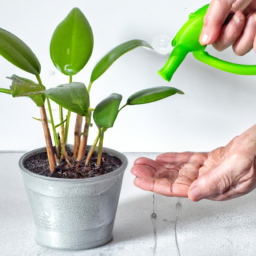
Finding the Right Balance: Watering and Light Requirements for Different Plants
Welcome to our guide on adjusting plant care to solve watering and light-related issues. As an expert in this field, I will provide you with a step-by-step approach to ensure your plants receive the optimal balance of water and light. Understanding the specific requirements of different plants is essential for their overall health and growth. So, let’s dive in and explore the world of plant care!
Understanding Watering Needs
Water is a vital element for plant survival, but it’s crucial to strike the right balance. Overwatering or underwatering can both have detrimental effects on your plants. The key is to understand the specific watering needs of different plants. Here are some general guidelines:
1. Observe and Assess: Start by observing your plants closely. Look for signs of wilting or drooping leaves, as these can indicate either underwatering or overwatering. Assess the soil moisture level by inserting your finger about an inch deep into the soil. If it feels dry, it’s time to water.
2. Watering Frequency: The frequency of watering depends on various factors such as plant type, size, and environmental conditions. Some plants, like succulents, prefer drier conditions and require less frequent watering. On the other hand, tropical plants may need more frequent watering. Research the specific watering needs of your plants to determine the ideal frequency.
3. Watering Techniques: When watering your plants, it’s important to water deeply and evenly. This encourages the roots to grow deeper and helps prevent waterlogging. Use a watering can or a hose with a gentle spray attachment to ensure even distribution of water. Avoid wetting the leaves excessively, as this can lead to fungal diseases.
Providing Adequate Light
Light is another critical factor that affects plant growth and development. Different plants have varying light requirements, and understanding these needs will help you provide the optimal conditions. Here’s what you need to know:
1. Assess Lighting Conditions: Start by assessing the lighting conditions in your home or garden. Identify areas with direct sunlight, partial shade, or full shade. This will help you determine the best location for each plant.
2. Sunlight Intensity: Different plants have different preferences for sunlight intensity. Some plants thrive in direct sunlight, while others prefer indirect or filtered light. Research the specific light requirements of your plants and place them accordingly.
3. Light Duration: The duration of light exposure also plays a crucial role. Most plants require a minimum of 6-8 hours of light per day. However, some plants, like certain succulents or ferns, may thrive with less light. Consider the natural light patterns in your home and supplement with artificial light if needed.
Striking the Right Balance
Now that you understand the watering and light requirements, it’s time to strike the right balance for your plants. Here are some additional tips:
1. Adjusting Watering Schedule: Monitor your plants regularly and adjust the watering schedule as needed. Remember, it’s better to underwater than overwater. If you notice signs of overwatering, such as yellowing leaves or root rot, reduce the frequency of watering.
2. Rotate Plants: If you have plants in areas with different lighting conditions, consider rotating them periodically. This allows each plant to receive its required amount of light and prevents them from leaning towards a single light source.
3. Provide Artificial Light: In spaces with limited natural light, consider using artificial light sources like grow lights. These lights provide the necessary spectrum for plant growth and can be adjusted to meet specific plant requirements.
Remember, each plant is unique, and finding the right balance may require some trial and error. By observing your plants closely, researching their specific needs, and making adjustments accordingly, you’ll be well on your way to becoming a plant care expert!
I hope this guide has been helpful in understanding how to adjust plant care to solve watering and light-related issues. Happy gardening!
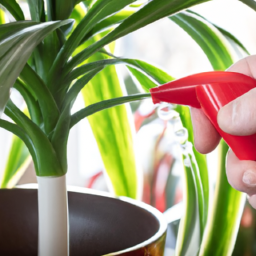
Introduction
Indoor plants are a beautiful addition to any space, bringing life and freshness to our homes. However, one of the most common challenges faced by plant enthusiasts is providing adequate light for their indoor plants. Insufficient light can lead to stunted growth, yellowing leaves, and even plant death. In this guide, we will explore the key factors to consider when adjusting plant care to solve watering and light-related issues. Specifically, we will dive into troubleshooting light-related problems and how to ensure your indoor plants receive the right amount of light they need to thrive.
Understanding Light Requirements
To effectively troubleshoot light-related problems, it’s crucial to understand the different light requirements of indoor plants. Light is essential for photosynthesis, the process by which plants convert light energy into chemical energy to fuel their growth. While each plant species has specific light requirements, they can generally be categorized into three groups: low light, medium light, and high light plants.
Low light plants, such as snake plants and pothos, can tolerate and thrive in areas with minimal light. They can survive in rooms with few windows or even in corners far from direct sunlight. Medium light plants, like peace lilies and philodendrons, prefer bright but indirect light. They can be placed near a window with sheer curtains or in rooms with moderate natural light. High light plants, such as succulents and cacti, require direct sunlight for several hours a day. They thrive in south or west-facing windows where they can receive intense sunlight.
Now that we understand the different light requirements, let’s identify some common light-related problems that indoor plants may face:
1. Yellowing Leaves: If your plant’s leaves are turning yellow, it may indicate insufficient light. Plants with inadequate light cannot produce enough chlorophyll, leading to yellowing foliage. However, be cautious not to confuse this with overwatering or nutrient deficiencies, which can also cause yellowing leaves.
2. Leggy Growth: Leggy growth refers to plants that have long, stretched-out stems with sparse foliage. This occurs when plants are reaching for more light. If your plant is growing tall and thin instead of bushy and compact, it’s a clear sign that it’s not receiving enough light.
3. Slow or No Growth: If your plant seems to be stagnant or growing at an extremely slow pace, it may be due to insufficient light. Without adequate light, plants cannot photosynthesize efficiently, resulting in stunted growth or no growth at all.
Adjusting Light Conditions
Now that we can recognize light-related problems, let’s explore some effective strategies for adjusting light conditions to ensure your indoor plants receive the right amount of light:
1. Repositioning: Start by repositioning your plants to areas that provide the appropriate light conditions for their specific needs. Low light plants should be placed in rooms with minimal natural light, while high light plants should be positioned near windows that receive direct sunlight. Experiment with different locations until you find the perfect spot for each plant.
2. Supplemental Lighting: If your indoor space lacks natural light or the available light is not sufficient, consider using supplemental lighting. LED grow lights are an excellent option as they provide a full spectrum of light that mimics natural sunlight. Place the grow lights above your plants, ensuring they are positioned at an appropriate distance to prevent heat damage.
3. Rotate Plants: To ensure all sides of your plants receive equal light exposure, rotate them regularly. This prevents uneven growth and encourages balanced development. A simple rotation every week or two can make a significant difference in your plant’s overall health.
4. Pruning: If your plant is experiencing leggy growth, pruning can help promote bushier growth. Trim back the long stems, focusing on removing the top growth. This encourages the plant to branch out and become more compact, utilizing available light more efficiently.
5. Monitor Light Levels: Invest in a light meter or use smartphone apps that measure light intensity. This allows you to accurately assess the light levels in different areas of your home and determine if adjustments are necessary. Monitoring light levels regularly helps you maintain optimal conditions for your plants.
Conclusion
By troubleshooting light-related problems and adjusting light conditions accordingly, you can provide your indoor plants with the optimal light they need to thrive. Remember to understand the light requirements of your plants, identify common light-related issues, and implement strategies such as repositioning, supplemental lighting, rotating, pruning, and monitoring light levels. With these steps, you’ll be able to create an ideal environment for your indoor plants, ensuring their health and vitality for years to come. Happy gardening!
Let’s recap
Taking care of plants can sometimes be a daunting task, especially when it comes to figuring out the right amount of water and light they need. Many plant enthusiasts struggle with overwatering or underwatering their plants, leading to their untimely demise. Similarly, understanding the ideal light conditions for different types of plants can be confusing. However, fear not, as this blog post aims to provide some simple solutions to these common plant care problems.
When it comes to watering, it’s crucial to strike the right balance. Overwatering can lead to root rot and other fungal diseases, while underwatering can cause wilting and stunted growth. To avoid these issues, it’s important to assess the moisture level of the soil before watering. Instead of sticking to a strict watering schedule, check the top inch of soil with your finger. If it feels dry, it’s time to water your plant. On the other hand, if it feels moist, hold off on watering for a few more days. Additionally, consider the type of plant you have and its specific water requirements. Succulents, for instance, prefer drier soil, while tropical plants thrive in more humid conditions.
Light is another crucial factor in plant care. Understanding the lighting needs of your plants can make a world of difference in their health and growth. Most plants fall into one of three categories: low light, medium light, and bright light. Low light plants, such as snake plants and pothos, can survive in areas with minimal natural light. Medium light plants, like peace lilies and philodendrons, require indirect sunlight. Bright light plants, such as cacti and succulents, need several hours of direct sunlight each day. Observing your plant’s behavior can also give you clues about its lighting requirements. If your plant starts leaning towards the light source or its leaves become pale, it might be indicating that it needs more light. Conversely, if the leaves turn yellow or brown, it could be a sign of too much direct sunlight.
By paying attention to the watering and light needs of your plants, you can ensure their well-being and help them thrive. Remember to assess the soil moisture before watering and adjust the frequency accordingly. Additionally, familiarize yourself with the lighting requirements of your plants and provide them with the appropriate amount of light. With these simple adjustments, you’ll be well on your way to becoming a successful plant parent.
Curious Minds Asked, We Responded. Frequently Asked Questions:
Q1: How often should I water my plants?
A1: The watering frequency for plants varies depending on several factors, including the type of plant, its size, and the environmental conditions. As a general rule, it’s best to water your plants when the top inch of soil feels dry to the touch. However, it’s important to consider the specific needs of your plants, as some may require more frequent watering while others prefer drier conditions. Monitoring the moisture level and adjusting your watering schedule accordingly will help ensure your plants receive the right amount of water.
Q2: How can I tell if my plants are getting too much or too little light?
A2: Determining if your plants are receiving the right amount of light is crucial for their health. Signs of insufficient light include elongated stems, pale or yellowing leaves, and stunted growth. On the other hand, if your plants are getting too much light, you may notice scorched or browned leaves. To find the ideal lighting conditions, observe your plants throughout the day and note any changes in their appearance. If necessary, adjust the placement of your plants to provide them with the appropriate amount of light.
Q3: What are some common mistakes to avoid when watering plants?
A3: Overwatering and underwatering are common mistakes that can harm your plants. Overwatering can lead to root rot and other fungal diseases, while underwatering can cause wilting and nutrient deficiencies. To avoid these issues, make sure to water your plants thoroughly but not excessively. Allow the soil to dry out slightly between waterings, as this promotes healthy root growth. Additionally, avoid watering your plants from above, as this can increase the risk of fungal infections. Instead, water at the base of the plant to ensure the roots receive the moisture they need.
Q4: How can I improve humidity levels for my plants?
A4: Some plants thrive in higher humidity levels, especially those native to tropical regions. To increase humidity for your plants, you can mist them regularly with water or place a tray filled with water near them. Another effective method is using a humidifier to maintain the desired humidity level. Additionally, grouping plants together can create a microclimate with higher humidity due to the moisture released through transpiration. Monitoring the humidity levels with a hygrometer and adjusting accordingly will help provide an optimal environment for your plants.
Q5: Is it better to underwater or overwater my plants when in doubt?
A5: When in doubt, it is generally better to underwater your plants rather than overwater them. Most plants can tolerate short periods of drought, but overwatering can lead to more severe consequences. If you are unsure about the moisture level of your plants, it’s best to wait until the soil has dried out slightly before watering again. Remember to consider the specific needs of your plants and their environmental conditions to ensure they receive the appropriate care.

Lisa Chen is a seasoned indoor gardening expert and the author of several bestselling books on the topic. With a background in horticulture and urban farming, Lisa is dedicated to helping urban dwellers embrace the joys of cultivating green spaces indoors. Her detailed guides and hands-on tips empower readers to transform their living spaces into thriving plant sanctuaries.

